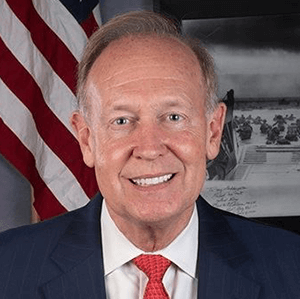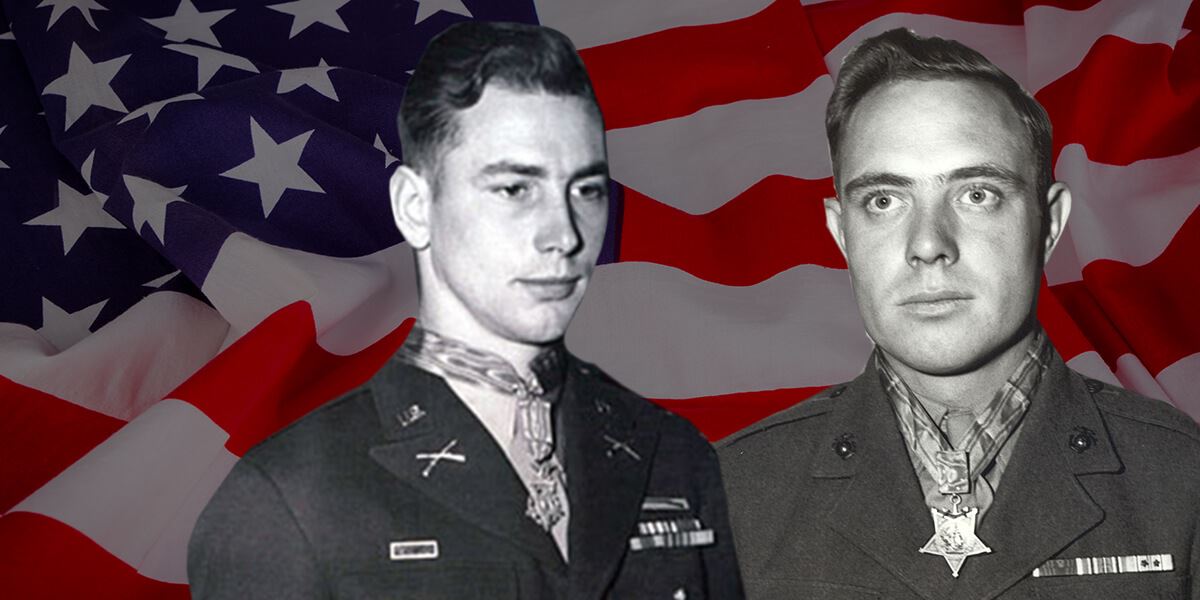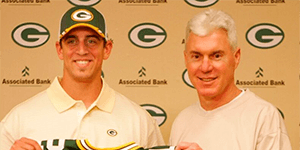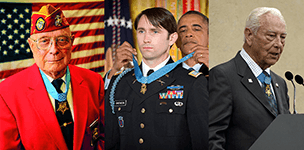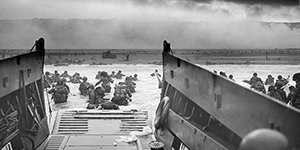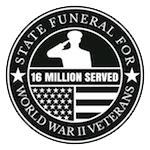American Hero Stories: What I Learned from Traveling with 2 Real American Heroes
Imagine if you could travel back in time with Davy Crockett or William Barrett Travis to the Alamo, return to the combat zone of Yorktown with George Washington or walk the battlefield of Gettysburg with Joshua Chamberlain or Robert E. Lee and learn their real American Hero stories. Today, most Americans never get the chance to shake hands with one of the 69 living Medal of Honor recipients and learn the American Hero Stories. I have experienced the honor of traveling with two World War II Medal of Honor heroes overseas to places where they fought, bled and emerged as victors. These places were Iwo Jima, Omaha Beach and the hedgerows of Normandy, France. Places well known to all patriotic Americans. The first hero, Walter D. Ehlers was a 23-year-old Army Sergeant. By the time he got to Omaha Beach in June of 1944 it was his third invasion. The other hero, Hershel “Woody” Williams was a 21-year-old Marine Corporal who had already battled to retake the U.S. island of Guam from the Japanese before hitting the beach on Iwo Jima in 1945. Let's get to the real American Hero Stories. I traveled with Walter Ehlers to the 60th anniversary of D-Day in France and with Woody Williams to the 73rd anniversary of Iwo Jima. In both cases, making a journey with them back to the actual locations where their Medal of Honor actions took place. Parts of the trips were surreal, others humorous and always thought provoking. I got to know both of them as friends spending many other occasions with them. Walter Ehlers became the Godfather to our daughter. Mr. Ehlers has since passed in February of 2014 and Mr. Williams is still going strong with a passion for life greater than most men 20 or 30 years his junior. Both were born when Warren G. Harding was President of the United States, one in 1921 and the other in 1923. Both were products of rural America, raised on farms. Each had a brother in service. Walt’s brother Roland Ehlers never made it to shore on Omaha Beach and was killed when his landing transport took a direct hit from a German shell. Woody’s brother, William Gerald Williams took two bullets during the Battle of the Bulge and survived. Unfortunately, he suffered from post-traumatic stress disorder the rest of his life. Each man’s story has them labeled by some historians as the ‘Greatest Medal of Honor Story Ever Told.” Other similarities include a high school education, enlisted men not officers, Republican leaning politically but not straight ticket voters, Both men enjoyed long marriages and had children and strong families who were very involved in their post war lives. Both had sons and grandsons who followed them into military service. In addition, they traveled the country and the globe to represent freedom and talk about liberty. Their American hero stories are worth spreading. Each of these men fully understood the fact that our liberty and freedoms are not guaranteed but hard-fought. Both were outstanding examples of why President Biden should use his sole authority to designate a State Funeral in Washington, DC for the final Medal of Honor recipient from the Second World War, as a final salute to the greatest generation.
Real American Hero StoriesHershel “Woody” Williams StoryWoody saw his first combat action when he fought in the battle to retake Guam from the Japanese in the hot summer of 1944, before moving on to Iwo Jima. These two battles were totally different. ''Guam was more jungle-type fighting — a lot of creeping and crawling — but when we got to Iwo Jima, everything had been wiped off that island. About the only protection you could find would be a shell crater or try to dig your own hole. Trying to dig a hole in that stuff was like trying to dig a hole in marbles," Williams explained of the volcanic island. "Trying to run on it was almost impossible. You couldn’t get a foothold." The tanks had trouble opening up a lane for the infantry through the sand, too, but the biggest problem was the many steel-reinforced pillboxes”. Woody said, "Bazookas and that sort of thing had no effect on them because they were so thick and well built. The only way to actually eliminate the enemy inside those pillboxes was by flamethrower.” Quick to volunteer his services when the Marines needed to open a lane for the infantry to come through the network of concrete pillboxes and buried mines, Williams went forward alone to attempt to stop the devastating machine-gun fire from the unyielding positions. Covered only by four riflemen, Woody fought desperately for hours under heavy enemy small-arms fire and repeatedly returned to his own lines to prepare demolition charges and obtain serviced flamethrowers. On one occasion, he mounted a pillbox to insert the nozzle of his flamethrower through the air vent, killing the occupants, and silencing the gun; on another, he grimly charged enemy riflemen who attempted to stop him with bayonets and destroyed them with a burst of flame from his weapon. He told me “as the men charged from the pillbox, they were dead men walking. The flamethrower sucks all the air from that small a space and it asphyxiated them.” For his brave activity that day, he was award what some call the “American Gold Medal” by President Truman at the White House. Two of the leathernecks who were tasked with providing cover fire for him that day were killed. It took many years, and some outstanding detective work by Mr. Patrick O’Leary, the National Veterans Affairs Manager for the United Parcel Service to ascertain their names and the places they were buried. On March 17, 2018, three of us accompanied Woody to the famous Punchbowl Cemetery in Honolulu. The others were his grandson Chad Graham and Mr. O’Leary of UPS. (The cemeteries actual name is the National Memorial Cemetery of the Pacific and it is a can’t miss stop on any Pearl Harbor/Honolulu tour) In the 73 years that had passed since these two men had been in proximity of each other, Woody had never forgotten Charles Fischler. A man he called one of those “guardian angels” who help him survive that life changing day. As we came to the simple horizontal tomb stone the rest of us stepped aside to give Mr. Williams sometime of contemplation. He eyes were moist as he seemed to shed decades of life, bring his right hand up to his garrison cap slowly, in a salute so sharp it would have made the Commandant of the Marine Corp proud. It was fitting that just a two hours earlier, Corporal Williams dedicated a Gold Star Monument in Kaneohe cemetery nearby. A Gold Start Family is one who has lost a family member in combat or military service. Most Americans think of Gold Star Families in terms of the movie Saving Private Ryan and scene with the military sedan pulling up to the mother’s farmhouse with the horrific news of her dead sons. 
Following our time in Hawaii, we flew to Guam and rested before our long day trip via chartered plane to Iwo Jima. The island belonged to America until President Lyndon Johnson gave it back to them as part of a trade deal in June of 1968. It is sad the Japanese only let American’s on the island one day a year, unless an American military plane needs to refuel. They annual ceremony is called Reunion of Honor. Iwo Jima is not only a home island of Japan, but it also falls under the jurisdiction of Tokyo, so the mayor always attends. No Japanese soldiers are still alive, but the sons of some of the Iwo Jima survivors do attend and they are fascinating to speak to for a few minutes. As the son of a U.S. Army World War II soldier myself, it makes for interesting conversation. Our flight from Guam on a United Airlines chartered 737, took about three hours. Also on board was the famous American businessman from Morgan City Louisiana, Mr. Greg Hamer, nicknamed “Big Food” because he owns over 130 Taco Bells and Kentucky Fried Chicken franchises. Mr. Hamer serves on the National Board of State Funeral for World War II Veterans. www.worldwar2salute.org Woody, traveling with his grandson Bryan Casey and daughter in law, caught up on his rest. There were a few other Iwo Jima veterans on our flight and from speaking with them and their families who brought them, they did not like being called “Iwo Jima survivors.” They are the “Iwo Jima victors”. After all there were hundreds of Japanese who survived. Some of them took months to surrender. Woody showed great humility in his choice of dress that day. All Americans and Japanese are required to wear a jacket and tie, which are to never come off while you are on the island as a sign of respect. This makes for some hot hiking to the invasion beaches or up to the top of the Mt. Surbachi once the morning ceremony is over. Woody wears a navy suite, with blue shirt, red, white and blue tie with some military scene on it, tie pin and a smart blue baseball cap with USS Iwo Jima LDH 7 on it. Here the humility begins. The USS Iwo Jima is an amphibious assault ship and Mr. Williams proudly sported that ship’s cap, complete with gold braid on the visor. But Woody Williams has his own Navy assault ship, the USS Herschel “Woody” Williams, launched in 2017 due to the efforts of West Virginia United States Senator Joe Manchin. Note: With the 50-50 tie in the United States Senate today, who is the most powerful U.S. Senator? Many believe the moderate Democrat Senator Joe Mansion will be the most powerful legislature in the U.S. Senate for the next two years. So, Woody Williams could have worn his own ships cap that memorable day on Iwo Jima, but he choose to put others first and wore another ships headgear. Once we landed, I closely watched Mr. Williams demeanor. Most of us walked the irregular in shape island, about 5 miles long and only a few hundred yards wide at its most narrow point. But the military gave Woody a Jeep and a driver. He was like a child at Disney World and certainly conducted himself like a victor, smiling and waving to all he passed as they took him up to the top of Mt. Suribachi for a truly magnificent view from where the most famous photograph in American history was taken by Joe Rosenthal. (Fun fact: it was taken twice) When I asked him where he was when the flag went up, he said “I was several thousand yards away near the airfield. I heard all the cheers and commotion but did not fully appreciate what it was. That day, I was very busy that day.” Knowing everyone asked him about his Medal of Honor action day, I asked him what he did the following day. He told the story of some Japanese soldiers in a large cave. Being an explosive expert, Woody was called on to take a Satchel charge, move towards the cave, expose himself to swing it in a circle and toss it into the cave mouth. “The darn thing did not go off!” Woody told me. “So, I had to expose myself to fire again, spin the strap around a couple of times and toss the second Satchel into the cave mouth again. Well, the second charge must have landed right on top of the first and the massive explosion blew me way back down the hill.” I then asked, “Woody were you successful?” He said “yes, they said there were something like 23 Japanese soldiers in that cave.” “What did I get for all this work? Nothing” said Mr. Williams with a laugh. At the end of a long day, we waited and asked him about a State Funeral for the final Medal of Honor recipient from World War II. He said “It would be a fitting tribute. The World War II veteran will soon be extinct. Our nation and our people forget easily. A State Funeral is part of history that cannot be erased. Regardless if it is me or Charles Coolidge (the other remaining MOH holder from WW2) it will be the final salute to a generation that saved the world from Imperialism, Fascism, and Nazism. “ Walter Ehlers StoryMy son and brother and I had dinner with Mr. Ehlers, and his daughter on the 60th anniversary of his Medal of Honor action, June 9, 2004. We were on a small ship off the coast of Normandy, France that had been chartered by the board of directors of the National World War II Museum in New Orleans. That evening Mr. Ehlers set the stage very well by saying that “June 6, 1944 was the most important day of the 20th Century.” As usual, this long tall farm boy from Kansas, even in his 83rd year of life, got it right. Former Nixon Speech writer Pat Buchanan, running for the nomination of his party for President once said if you really want to understand America, you need to visit three places, Gettysburg, the Alamo and Omaha Beach. To see the wide expanse of Omaha Beach at low tide in the early morning fog, gives one chills to think of exposure the boys of the Big Red One first division and the 29th Infantry Division faced the morning of June 6, 1944. That day, staff sergeant and squad leader Ehlers got all his men safely. He told me it was the best thing he ever did in his life. For this leadership he was awarded the Silver Star. Three days later Walt Ehlers and his men had fought their way 8 miles inland into the hedge country. The famous French author Balzac described the hedgerows this way. “The peasants, from time immemorial, have raised a bank of earth about each field forming a flat-topped ridge, two meters (6 ½ feet) in height, with beeches, oaks and chestnut trees growing upon the summit.” 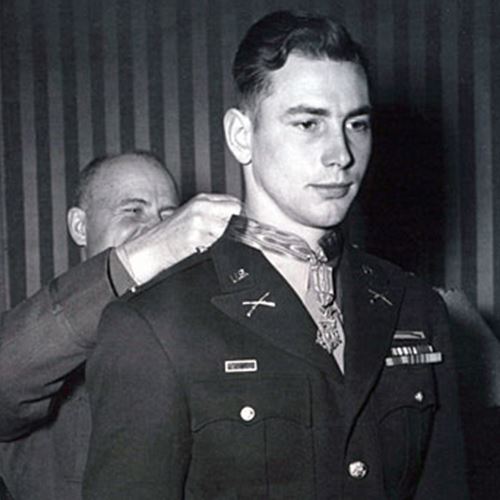
Walt Ehlers always acted as the spearhead for his unit repeatedly leading his men against heavily defended enemy strongpoints, exposing himself to hostile fire whenever the situation required heroic and courageous leadership. Without waiting for an order, Staff Sgt. Ehlers, far ahead of his men, led his squad against a stoutly defended enemy strongpoint, personally killing four men of the enemy patrol who attacked him en-route. Then crawling forward under withering machine-gun fire, he trounced upon the gun-crew and put it out of action. I asked him how he did it and he told me he only used his bayonet! Turning his attention to two mortars protected by the crossfire of two machine guns, Staff Sgt. Ehlers led his men through this hail of bullets to kill or put to flight the enemy of the mortar section, killing three men himself. After mopping up the mortar positions, he again advanced on a machine gun, his progress effectively covered by his squad. Walt Ehlers knew the only way to make it through this intense battle was to keep moving forward and to not look back. When he was almost on top of the next gun he leapt to his feet and, although greatly outnumbered, he knocked out the position singlehandedly. The next day, having advanced deep into enemy territory, the platoon of which Staff Sgt. Ehlers was a member finding itself in an untenable position as the enemy brought increased mortar, machine-gun, and small-arms fire to bear on it, was ordered to withdraw. Staff Sgt. Ehlers, after his unit had covered the withdrawal of the remainder of the platoon, stood up and by continuous fire at the semicircle of enemy placements, diverted the bulk of the heavy hostile fire on himself, thus permitting the members of his own squad to withdraw. He blatantly put his life at stake for the betterment and safety of others in his platoon. At this point, he carried one of his wounded riflemen to safety and then returned fearlessly over the shell-swept field to retrieve the automatic rifle that he was unable to carry previously. I asked him why he went back into the firefight to retrieve the BAR rifle. He replied that each squad only had one machine gun (BAR) and he was not going to let the enemy kill him with their own gun! After then having his wounds treated, he refused to be evacuated and returned to lead his squad. The bullet went through his side, into his pack, through a picture of his mother, before hitting a trenching tool, and exiting out the back of the pack. The exit hole was huge and the medical personal nearly fainted when they saw it, thinking he had been shot clean through his chest! Today, in the Road to Berlin Section of the World War II Museum in New Orleans you can see Uncle Walt’s Medal of Honor and the photo of his mother with the German bullet hole in it. This alone is well worth the price of admission! Mr. Ehlers never found the location where his Medal of Honor action took place. He looked for it on several trips, including his 1964 trip to the 20th anniversary with Congressman Olin “Tiger” Teague, himself the holder of a Silver Star. His daughter Kathy feels the writers of the report were wrong and they were perhaps not near Goville, but some other small village. Other things of interest conveyed to me on this trip and through the years include the following:
The Congressional Medal of Honor Society uses these words to describe a MOH recipient, “Gallantry in action. Intrepidity. Above and beyond the call of duty. Risk of life. Selflessness. Exemplary action. Unwavering devotion. Conspicuous gallantry. Extraordinary heroism.” The words enshrined with the Medal of Honor citations capture the best of what it means to be human. By remembering, supporting, and honoring the sacrifice of men like Woody Williams and Walt Ehlers, we pass the true meaning of freedom to the next generations. One his death bed, Walt Ehlers remembered one of his many fellow Medal of Honor recipients. Guess which one? He told his family, “Tell Woody Williams that I love him”. | Suggested Articles |
| Privacy Policy Site Map 501(c)(3) Status Disclaimer |
